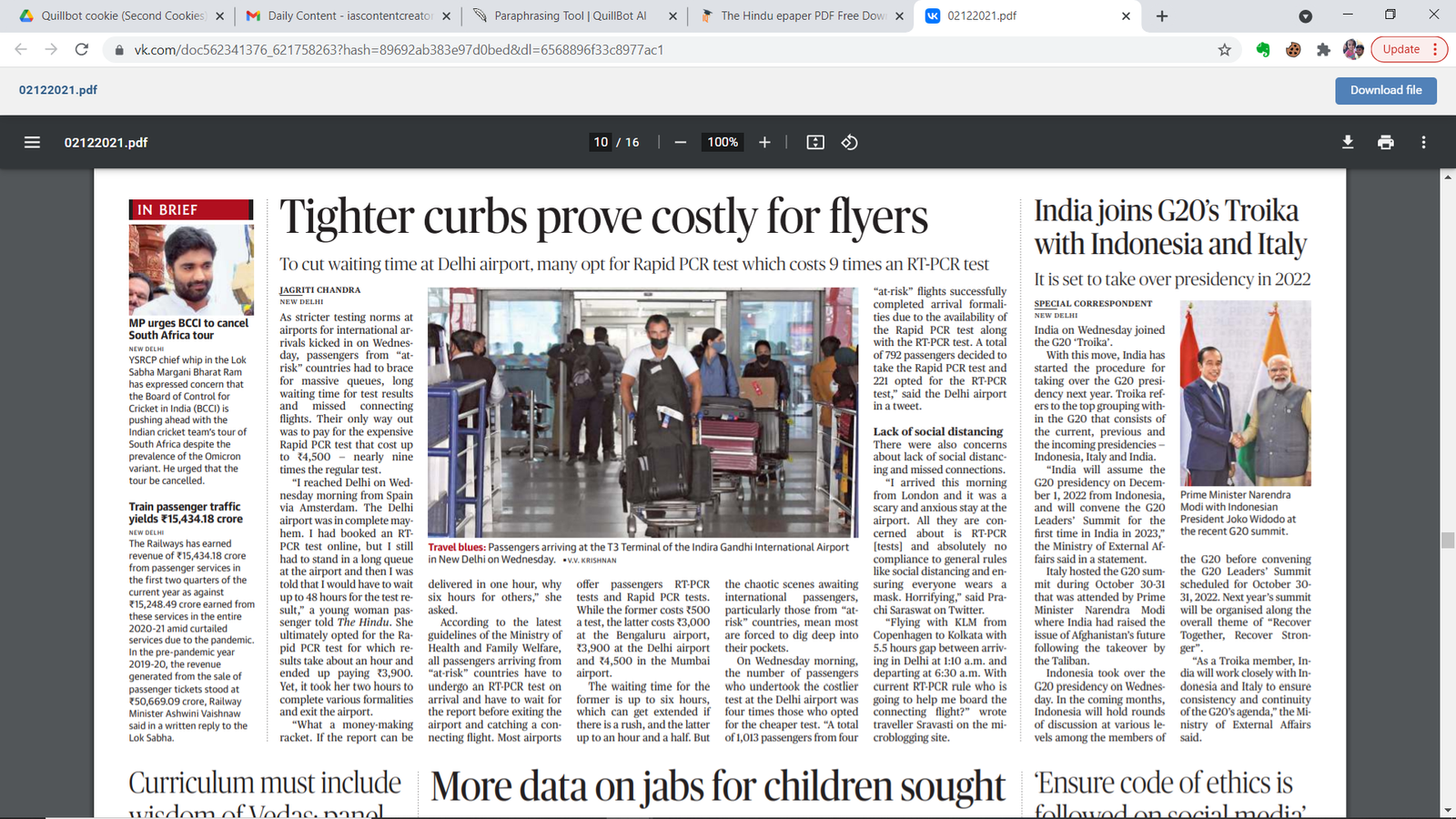
Prepare IAS Coaching
Current Affairs

Title : G 20: a new view
Date : Dec 02, 2021
Description :
G 20:
Based on a News Article published in the ‘The Hindu’ on 02nd December 2021 on Page Number 10
Useful for UPSC CSE Prelims and Mains (GS Paper I & II)
What exactly is the G20:
- The G20 is an informal organisation comprising 19 countries and the European Union, as well as officials from the World Bank and the International Monetary Fund.
- The G20 membership is made up of a mix of industrialised and emerging economies, representing over two-thirds of the worldwide population, 85 percent of global GDP, 80 percent of global investment, and over 75 percent of global commerce.
Origin of G 20:
- The Economic Crisis of 1999 & 2008: After the G7 invited both rich and developing economies, this was a ministerial-level summit. The first conference of finance ministers and central bank governors took place in 1999.
- During the 2008 financial crisis, the world recognised the need for a new level of political agreement. It was determined that the G20 leaders will meet once a year from now on.
- The G20 finance ministers and central bank governors continue to meet on their own twice a year to help prepare for these summits. They convene at the same time as the World Bank and the International Monetary Fund.
How Does the G20 Work:
- The G20's work is split into two tracks:
- All talks involving G20 finance ministers and central bank governors and their deputies are part of the finance track. They meet numerous times a year to discuss monetary and fiscal concerns, as well as financial rules.
- The Sherpa track focuses on broader topics like political engagement, anti-corruption, development, and energy, among others.
- Each G20 country is represented by a Sherpa, who plans, guides, implements, and so on on behalf of the country's leader. (Shriktikanta Das, an Indian Sherpa, represented India at the G20 in Argentina in 2018.)
Members of the G20:
- Argentina, Australia, Brazil, Canada, China, France, Germany, India, Indonesia, Italy, Japan, Republic of Korea, Mexico, Russia, Saudi Arabia, South Africa, Turkey, United Kingdom, United States, and European Union are all members of the G20.
- Spain participates in leader summits as a permanent non-member invitee.
G20 Structure and Functioning:
- The G20 Presidency is rotated every year in accordance with a structure that ensures regional balance over time.
- The 19 countries are divided into five groups, each with no more than four countries, for the purpose of selecting the president. Each faction takes turns holding the presidency. Every year, the G20 elects a president from a different group.
- In Group 2, India is joined by Russia, South Africa, and Turkey.
- There is no fixed secretariat or headquarters for the G20. Instead, the G20 president is in charge of bringing the G20 agenda together in conjunction with other members and in reaction to global economic events.
TROIKA:
- Every year, when a new country becomes the president (in this case, Argentina in 2018), it collaborates with the previous presidency (Germany in 2017) and the following presidency (Japan in 2019) to form TROIKA. This maintains the group's agenda's continuity and coherence.
Cooperation:
- Leaders declared Toronto to be the primary venue for global economic cooperation in 2010.
- Several international organisations that give policy advice support the activities of G20 members.
- These are some of the organisations:
- The Financial Stability Board is a body that oversees financial stability (FSB). Following the commencement of the global financial crisis, G20 leaders established the Financial Stability Board (FSB) and the International Labour Organization (ILO) (ILO).
- The International Monetary Fund (IMF) is a financial institution that exists to help (IMF).
- The Organisation for Economic Cooperation and Development (OECD) is an international organisation that promotes economic development (OECD)
- The United Nations (UN)
- The World Bank is a multilateral financial institution that
- The G20 collaborates with non-government sectors on a regular basis, as does the World Trade Organization (WTO). Throughout the year, engagement groups from business (B20), civil society (C20), labour (L20), think tanks (T20), and youth (Y20) will organise important events, the findings of which will inform G20 leaders' deliberations.
Issues addressed by G 20:
- The G20 focuses on a broad agenda of global issues; while issues related to the global economy dominate the agenda, other items have become more prominent in recent years, such as:
- Markets for financial instruments
- Fiscal and tax policy
- Trade
- Agriculture
- Employment
- Energy
- Anti-corruption campaign
- Women's advancement in the workplace
- 2030 Agenda for Sustainable Development Development that is long-term
- Changes in the Climate
- Health Around the World
- Anti-terrorism
- Entrepreneurship that is inclusive
India's G20 Summit Priorities:
- Tax evasion is being investigated in order to combat corruption.
- Putting a stop to terror funding
- Remittance costs are being reduced.
- Key medications have market access.
- The World Trade Organization is undergoing reforms to increase its efficiency.
- The Paris Agreement's "full implementation"
Achievements of G 20:
- Flexible: The G20 is small enough to make quick choices and respond to new issues, with only 20 members.
- Inclusive: The inclusion of invited countries, international organisations, and civil society organisations through engagement groups every year allows for a larger and more thorough viewpoint when assessing global concerns and reaching consensus on solutions.
- Action that is coordinated: The G-20 has also contributed significantly to the building of the international financial regulatory framework, including improved cross-country cooperation.
- Assisted in a US$235 billion surge in loans from multilateral development banks at a time when private sector sources of finance were dwindling.
- During the global financial crisis of 2008, one of the G20's major accomplishments was the rapid deployment of emergency money.
- It also strives to improve monitoring of national financial institutions in order to promote reforms in international financial institutions. Reforms to the international tax system driven by the G20/OECD Base Erosion and Profit Shifting (BEPS) project, as well as the implementation of tax transparency standards, are examples.
- The G20 was instrumental in the passage of the Trade Facilitation Agreement, which the World Trade Organization estimates may contribute between 5.4 and 8.7% of global GDP by 2030 if fully implemented.
- Improved Communication: The G20 brings together the world's most developed and developing countries to explore how to bring consensus and rationale into decision-making.
Challenges associated with G 20:
- There is no enforcement mechanism in place: The G20's toolset includes everything from simple information exchanges and best practises to setting clear, measurable goals and taking concerted action. Except for the incentive of peer review and public responsibility, none of this is possible without consensus, and none of it is enforceable.
- The judgments are not legally binding because they are based on debates and consensus that result in declarations. These statements are not legally enforceable. It's only a 20-person advisory or consultative group.
Next Steps:
- The G20 will not be able to solve all of the world's problems.
- The G20, on the other hand, has been an important venue for international cooperation for the previous ten years.
- Effective global governance, like the G20, is essential as rising powers seek opportunities to influence and contribute to the global order.
